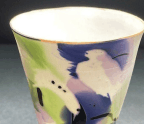Owen Rye: A Daedal Gallimaufry

Owen Rye’s autumn exhibition, A Daedal Gallimaufry, curated by Skepsi’s Anna Maas, was a tour de force in many ways, not least in its fortuitous timing. The bushfires were doused, finally, and the virus a low whisper (in Australia) at the time of the show’s opening. By its close, there was leisure and calm enough – just – for keen buyers to venture out to Eltham’s Montsalvat to collect their treasures. The show’s final day marked almost the last of what we once called ‘normal life’.
But it was not just a quirk of fate that made this exhibition memorable. Owen Rye’s pots have an elemental quality, a dynamic stillness that seems to exist outside of time, or at least outside time as we obsessively measure and spend it. His pots conjure rock strata, lava flow, crystalline recesses; they seem extruded from some molten core rather than fashioned with hands on a wheel. Yet they are also lively, hinting at the organic: the celadon glint of lichen on basalt or the tadpole wriggle of a mixed ash glaze as it forever seeks the centre of a perfect bowl. Sometimes his pots are stately, other times elegiac. And in the
You’re reading a preview, subscribe to read more.
Start your free 30 days



